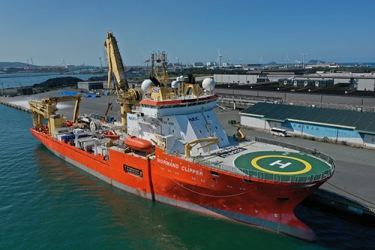NEC has signed a charter contract with U.K.-based Global Marine Systems Limited for an optical submarine cable-laying ship (the Norwegian registered Normand Clipper) for approximately four years.
Based on this contract, NEC intends to strengthen its position to provide submarine cable systems and thus respond to expanding demand for submarine cables due to the increase in global data traffic.
Currently located in a northern port on the Japanese island of Kyushu the Normand Clipper arrived on October 1st after a voyage of 39 days from Portland, UK.
NEC says that it has been a leading global vendor in the submarine cable system business for over 50 years, manufacturing submarine cables, submarine repeaters, and terminal station equipment. In fact various subsidiaries will be involved in most aspects of sub-sea cable deployment from the contracted vessel. The submarine cable will be manufactured by NEC’s subsidiary OCC Corporation and submarine relaying devices will be manufactured by NEC Platforms Ltd.
Further, the company has been actively involved in the coordination of marine surveys, route design, equipment installation work, cable laying, training and delivery testing.
|
|
For previous projects, NEC has procured submarine cable-laying ships for each project separately. In order to respond to the growing demand for new submarine cables due to the recent spread of 5G and the increase in data traffic between data centres in various countries, NEC has chartered a long-term dedicated cable-laying ship for the first time. As a result, NEC will provide submarine cable systems more quickly and flexibly than ever before to meet customer demand.
One of the biggest consumers of cable bandwidth is “follow the electricity price” data centre usage. Most global data centre managers will very closely watch electricity prices around the world and rapidly relocate customers’ virtual machines to take advantage of the lowest price wherever they have an active data centre.
Sub-sea cable-laying has become big business with demand for new capacity growing rapidly. In addition, there has long been a need for duplicated cables in areas serviced by only one cable – the recent outage in Tonga being an obvious example. Further, sub-sea mud flows have occasionally cut cables, so any duplicate capacity in high risk areas is also beneficial.
Currently, most sea-facing countries are serviced by these cables and any increase in service will almost certainly be consumed very quickly.










































